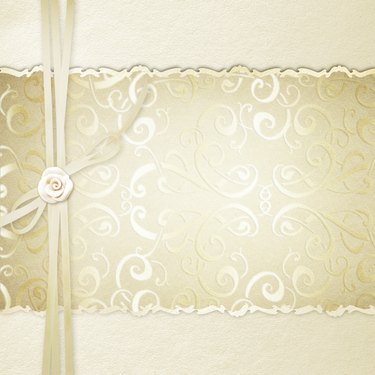
Save the date postcards inform friends and family about an upcoming special event you don't want them to miss, such as a wedding, anniversary or reunion. Depending on the occasion and how close you are to those you are inviting, select a formal addressing style, an informal one or a mixture of both. Use the manner in which you address the cards to indicate who is invited, for example, whether children or a date can also attend. The more specific you are in addressing the postcards, the fewer questions you will have to field about add-on guests.
Close Friends and Family
Video of the Day
Step 1
Decide how formal you want to be in the way you address your close friends and family. Most of your close friends and family will likely be comfortable with names without formal titles such as "Mr.," "Mrs." and "Ms," as you probably refer to them by their first names. Senior adults, such as your grandparents, may find titles more comfortable, for example, "Mr. and Mrs. Thomas McCorkle."
Video of the Day
Step 2
List the wife's name first for married couples, for example, "Sue and Jack Taylor," on one line. Place the names on separate lines for couples who are not married or do not share a surname, for example, "Mary Campbell" on one line and "Jeffrey Adams" on the line below it. Order the names alphabetically or in the order of person you are closer to if the invitees don't share a surname or are the same gender.
Step 3
Address the postcard to the entire family if you are inviting a couple with children, for example, "The Sanchez Family" or "Ruth and Paul Snyder and family."
Step 4
Address the card to a single person who may bring a guest as "Jake Potter and guest," for example. If bringing a guest is not an option, address the card only to the invited person.
Step 5
Discard the postcard if you make a mistake when writing the name or address. Do not try to correct it with liquid paper or by marking it out and rewriting.
Distant Friends and Dignitaries
Step 1
Select a more formal address style for distant friends and dignitaries you invite, such as the minister of your church, a city official, your parents' best friend or higher management at your workplace. Spell out the entire name with the appropriate title, such as "Mr. David Friend," "Rev. Sally Smith," "Rabbi Joseph Stein," "Doctor William Bryant" or "The Honorable Jacob Sullivan and Mrs. Sullivan."
Step 2
Place each name on a different line if each member of a couple has a title to acknowledge, such as "Elizabeth Winters, Ph.D." on one line and "Professor Samuel Winters," on the second line.
Step 3
Utilize "Miss" for all young, unmarried women from birth to 20 years of age and "Ms." for unmarried women who are older. Young boys below age 9 can be addressed as "Master Paul Carter," for example. Boys between the ages of 9 and 15 can be listed without a title, and those over the age of 16 should be addressed as "Mr."
Tip
Follow the names with legibly written addresses, including the zip code. Verify each address for accuracy against your list after you write it. When in doubt about the formality of your address style, consider the event and use a formal style for a formal event, such as a cotillion or formal ball and an informal style for a child's birthday or a family gathering.